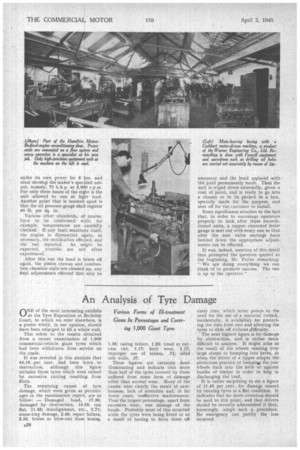An Analysis of Tyre Damage
Page 30

If you've noticed an error in this article please click here to report it so we can fix it.
Various Forms of I11-treatment Given In Percentages and Covering 1,000 Giant Tyres ONE of the most interesting exhibits at the Tyre Exposition at Berkeley Court, to which we refer elsewhere, is a poster Which, in our opinion, should have been enlarged to fill a whole wall.
This refers to the results. obtained from a recent examination of 1,000 commercial-vehicle giant tyres which had been withdrawn from service on the roads.
It was revealed in this analysis that 44.19 per cent. had been worn to destruction-, although this figure inCludes those tyres which were ruined by excessive cutting resulting from flints.
The remaining causes of tyre damage, which were given as percentages in the examination report, are as
follow: — Damaged bead, 17.36;. damaged by obstruction, 13.55; run flat, 11.45; misalignment, etc„ 2.71; stone-trap damage, 2.46; repair failure, 2.3-4; bruise or blow-out from braisq, 1.35; casing failure, 1,23; tread or carcase cut, 1.17; kerb wear, 1.17; improper use of brakes, .74; oiled side walls, .37.
These figures are certainly most illuminating and indicate that more than half of the tyres covered by them suffered from some form of damage other than normal wear. Many of the causes were clearly the result of carelessness, lack of attention and, in far fewer cases, ineffective maintenance. Thus the largest percentage, apart from excessive wear, was damage of the beads. Probably most of this occurred while the tyres were being fitted or as a result of having to force them off
rusty rims, which latter points to the need for the use of a material (which, incidentally, is available) for protecting the rims_ from rust and allowing the tyres to slide off withoutilifficulty.
The next highest figure is for damage by obstruction, and is rather more difficult to analyse. It might arise as the result of the wheels running over large stones or bumping Into kerbs, as when the driver of a tipper adopts the pernicious practice of bump* the rear wheels back into the Iterb or against baulks of timber in order to help in discharging the' load.
It is rather surprising to see a figure of 11,45 per cent, for damage caused by running tyres in a flat condition. It indicates that far more attention should be paid to this point, and that drivers should be severely admonished if they, knowingly, adopt such a procedure. No emergency can justify the loss incurred,




















































